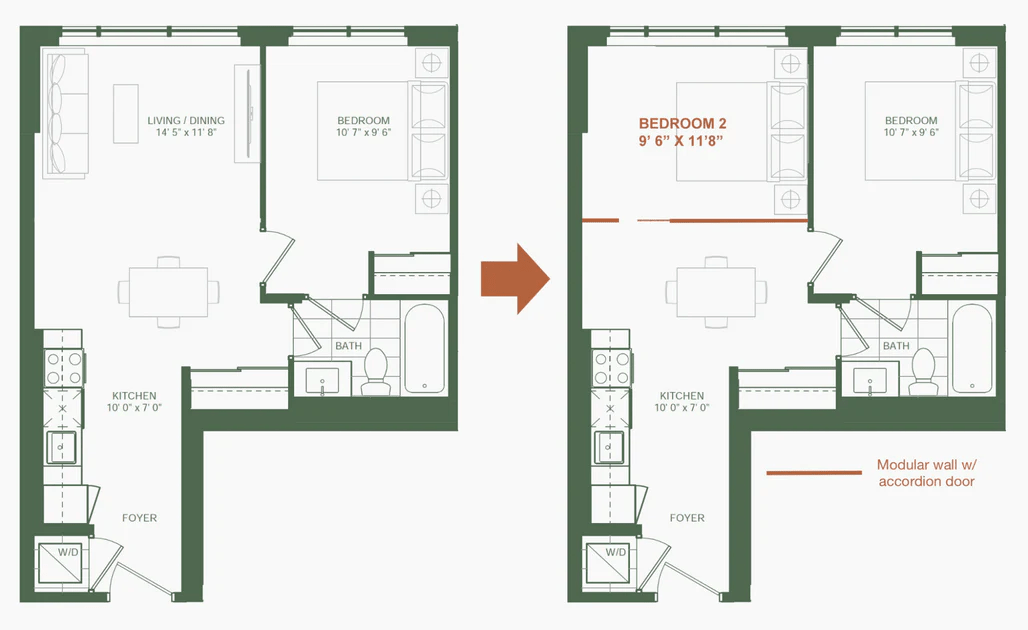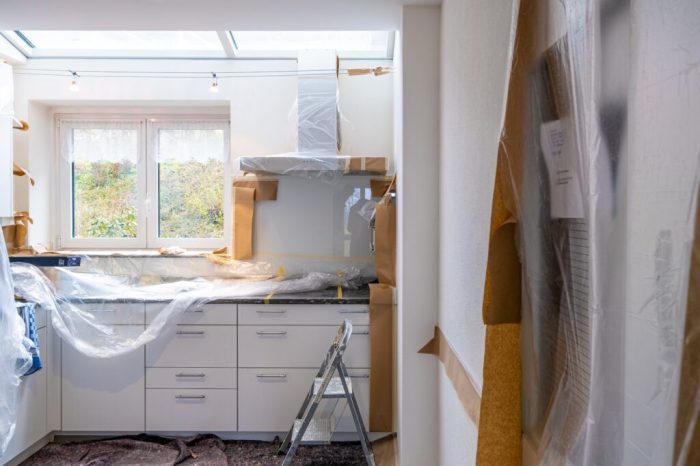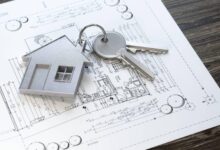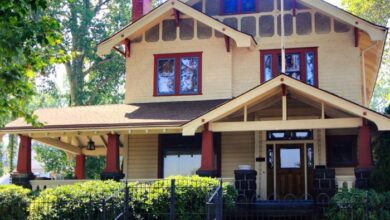Top Renovations To Boost Rental Income From Your Property
The world of rental properties is ever-evolving, and making the right renovations can significantly elevate your rental income. With today’s market trends shifting, understanding which upgrades yield the best returns is crucial for landlords looking to maximize profitability. Whether it’s modernizing kitchens or enhancing curb appeal, strategic renovations can entice tenants and justify higher rent.
This guide delves into the most impactful renovations that can not only attract quality tenants but also enhance the overall value of your property. From comprehensive kitchen upgrades to energy-efficient solutions, we’ll explore how to create a space that meets the demands of modern renters while ensuring a solid return on your investment.
Introduction to Renovations for Rental Properties
Renovations play a crucial role in enhancing the appeal and functionality of rental properties, directly impacting the income they generate. Property owners who invest in renovations not only improve the living experience for tenants but also increase the overall value of their investment. As the rental market evolves, understanding the significance of these updates becomes essential for maximizing returns.Current market trends highlight a growing demand for modern amenities and aesthetics in rental properties.
As more tenants prioritize comfort and convenience, properties featuring upgraded kitchens, bathrooms, and energy-efficient installations are becoming more attractive. According to recent studies, properties that undergo renovations can see a rental income increase of 10% to 25%, depending on the scope and quality of the upgrades. This trend underscores the importance of staying competitive in the rental market.
Impact of Renovations on Rental Rates
The impact of renovations on rental rates is significant, as they can transform a property into a more desirable living space. Investing in strategic renovations is not just about aesthetics; it’s also about addressing tenant needs and preferences. Some key renovations that can influence rental rates include:
- Kitchen Upgrades: Modernizing kitchens with new appliances, countertops, and cabinetry can substantially increase rental value. Tenants often prioritize this space as a focal point in their home.
- Bathroom Remodels: Updated bathrooms with contemporary fixtures and efficient layouts can attract higher rents, especially in competitive markets.
- Energy Efficiency Improvements: Adding insulation, energy-efficient windows, and HVAC systems can lower utility costs for tenants and make properties more attractive.
- Fresh Paint and Flooring: A new coat of paint and updated flooring can refresh the look of a rental property, making it more inviting and reducing vacancy times.
- Outdoor Spaces: Enhancements like landscaping, decks, or patios can provide additional living space, making a property more appealing to potential renters.
With these renovations, landlords can not only increase their rental income but also reduce vacancy periods, as well-maintained properties tend to attract tenants more quickly. A well-renovated property can command premium rates, making it a worthy investment for property owners seeking to maximize their returns. Investing in renovations is more than just a financial decision; it’s about creating a home that tenants will love and want to stay in long-term.
Kitchen Renovations

Source: diyversify.com
Renovating the kitchen is one of the most effective ways to attract quality tenants and maximize rental income. A well-designed kitchen not only improves the functionality of the space but also enhances the overall appeal of the property. Tenants often prioritize kitchens when looking for rental properties, making it essential to invest in upgrades that resonate with their needs and preferences.To make impactful kitchen renovations, focus on essential upgrades that deliver high returns on investment.
Cost-effective enhancements can significantly elevate the kitchen’s attractiveness without breaking the bank. Elements such as new cabinetry, countertops, and flooring can dramatically transform the space while staying within budget constraints. Additionally, the choice of modern appliances plays a pivotal role in rental appeal, as tenants gravitate towards homes equipped with energy-efficient and stylish appliances.
Essential Kitchen Upgrades for Rental Appeal
Investing in certain kitchen features can create a significant difference in attracting tenants. Consider the following upgrades that are proven to enhance rental appeal:
- Cabinetry: Replacing or refinishing cabinets can give the kitchen a fresh, modern look, making it more inviting. Opt for neutral colors that appeal to a broader audience.
- Countertops: Upgrading to quartz or granite countertops adds a touch of luxury, which can justify a higher rental price. They are also durable and easy to maintain.
- Flooring: Installing new, durable flooring such as vinyl plank or laminate can enhance the kitchen’s overall aesthetics and withstand the wear and tear of daily use.
- Backsplash: Adding a stylish backsplash can serve as a focal point, providing both functionality and visual interest. Consider easy-to-clean materials to appeal to practical tenants.
- Lighting: Modern, energy-efficient LED lighting can brighten up the kitchen and improve its ambiance. Consider pendant lights over the kitchen island for a trendy touch.
Modern appliances are another crucial aspect of kitchen renovations that can significantly boost rental appeal. Tenants appreciate having updated, energy-efficient appliances that not only make cooking easier but also help reduce utility bills. Investing in stainless steel appliances can lend a contemporary feel to the kitchen and is often perceived as a sign of quality.
“Properties with modern kitchens equipped with energy-efficient appliances can often command a rental premium of 10% to 20%.”
Incorporating modern features and appealing aesthetics in the kitchen can lead to higher tenant satisfaction and lower vacancy rates, making it a sound investment for property owners looking to enhance their rental income.
Bathroom Upgrades
Renovating bathrooms in rental properties can significantly boost rental income. A modern and functional bathroom is a strong selling point for potential tenants, enhancing their overall living experience. As tenants often prioritize cleanliness and convenience, investing in bathroom upgrades can yield high returns.Bathroom upgrades should focus on essential features that appeal to renters while also being cost-effective. Key elements include high-quality fixtures, efficient storage solutions, and durable materials that stand up to regular use.
Modern tenants appreciate sleek designs and functionality, which can make your property more attractive in a competitive rental market.
Must-Have Features for Modern Bathrooms
A well-designed bathroom can elevate the overall appeal of a rental property. Here are some must-have features to consider including:
- Double Sinks: Ideal for families or roommates, double sinks help minimize morning rush hour conflicts.
- Walk-In Showers: Easy to clean and accessible, walk-in showers create a spacious feel and can be fitted with glass doors for a modern touch.
- Quality Fixtures: Upgrading to water-efficient faucets and showerheads not only conserves water but also enhances the bathroom’s aesthetic appeal.
- Good Lighting: Bright, well-placed lighting fixtures improve functionality and ambiance, making the space feel larger and more inviting.
- Storage Solutions: Built-in shelving and cabinetry maximize space and keep the bathroom organized, which is especially valuable in smaller units.
Affordable Materials for Bathroom Renovations
When renovating bathrooms, selecting affordable materials that do not compromise on style or durability is essential. Here are some cost-effective options:
- Vinyl Flooring: A budget-friendly alternative to tile, vinyl is available in various designs and is waterproof, making it ideal for bathrooms.
- Laminate Countertops: These can mimic the look of natural stone at a fraction of the cost and are easy to maintain.
- Faux Wood Tiles: Offering the warmth of wood with the durability of ceramic, faux wood tiles are perfect for a modern, rustic look.
- Shower Wall Panels: Instead of expensive tile, acrylic or fiberglass panels can be a sleek and low-maintenance option.
- Paint: A fresh coat of paint in a neutral color can instantly modernize the space and is one of the least expensive upgrades.
Impact of Adding Additional Bathrooms
Increasing the number of bathrooms in a property can significantly enhance its rental appeal and value. Properties with more bathrooms typically attract higher rents and a broader range of potential tenants. For example, a three-bedroom house with two bathrooms can command a higher price than a similar house with only one bathroom, catering to families or shared living arrangements. Adding additional bathrooms can transform the rental income potential, especially in areas where demand for housing is high.
Consider the investment versus the potential return: often, the costs associated with adding a bathroom, such as plumbing and construction, can be recuperated swiftly through increased rental rates.In summary, strategic bathroom upgrades, from modern features to wise material choices, can make a rental property more appealing and profitable. Investing in the right renovations ensures long-term benefits and enhances tenant satisfaction.
Curb Appeal Improvements
Enhancing the curb appeal of your rental property is crucial for attracting potential tenants and increasing rental income. The exterior of your property is the first impression tenants will have, and a well-maintained façade can set the tone for the entire rental experience. Fortunately, there are several strategies to elevate your property’s attractiveness without breaking the bank.Landscaping plays a pivotal role in creating an inviting atmosphere.
Simple improvements can yield significant results. Consider the following landscaping options:
Landscaping Options for Enhancement
Investing in landscaping can transform an ordinary property into a standout rental. Here are some effective options to consider:
- Native plants and flowers: Incorporating native species requires less maintenance and water while providing a natural aesthetic.
- Mulching: Using mulch not only enhances the look of garden beds but also suppresses weeds and retains moisture in the soil.
- Pathways and edging: Well-defined pathways made from stone or wood chips can lead tenants through the garden, adding structure and appeal.
- Seasonal displays: Rotating seasonal flowers or decorations can keep the entrance looking fresh and inviting throughout the year.
In addition to landscaping, exterior renovations can dramatically alter the perception of your property. These improvements not only enhance aesthetic appeal but also protect the property from wear and tear.
Exterior Renovations
The exterior of your rental property deserves attention, and a few updates can make a world of difference. Here are some renovations to consider:
- Painting: A fresh coat of paint can rejuvenate any property. Opt for neutral colors that appeal to a broad audience and ensure the paint is weather-resistant.
- Siding updates: Replacing old or damaged siding with modern materials like vinyl or fiber cement can improve insulation and enhance durability.
- Window treatments: Updating window frames or adding decorative shutters can add character and charm.
Entryways and porches are often overlooked yet play a critical role in curb appeal. Simple upgrades can significantly enhance these areas without extensive remodeling.
Entryway and Porch Upgrades
A welcoming entryway sets the tone for the entire property. Here are low-cost upgrades that can make a substantial impact:
- New door hardware: Replacing outdated doorknobs and locks with modern fixtures can add a touch of elegance.
- Outdoor lighting: Installing stylish light fixtures can illuminate the entryway, making it safe and inviting.
- Fresh paint on the door: A bold color can make the entrance pop, creating a visual focal point that draws tenants in.
- Comfortable seating: Adding a small bench or chairs on the porch encourages relaxation and enhances the inviting feel of the home.
Flooring and Interior Design
Renovating your rental property’s flooring and interior design can significantly enhance its appeal and value. The right choices can attract a broader range of tenants and ultimately boost your rental income. Understanding the various flooring options and the importance of an open floor plan can help you make informed decisions that resonate with potential renters.
Comparison of Flooring Options
Selecting the right flooring can play a pivotal role in setting the tone of your rental property. Different materials offer various aesthetic benefits and functional attributes. Here are some popular flooring options to consider, along with their rental appeal:
- Hardwood: A classic choice that adds warmth and elegance, hardwood floors are often sought after by tenants. They are durable and can last a long time with proper maintenance, but they can be on the pricier side.
- Laminates: More affordable than hardwood, laminate flooring mimics the look of wood while offering enhanced durability against scratches and moisture. This makes it an appealing choice for rental properties.
- Luxury Vinyl Plank (LVP): This option offers the appearance of wood or tile at a lower cost and is water-resistant, making it suitable for high-traffic areas. Its versatility and ease of installation make it attractive to landlords.
- Tile: Ceramic or porcelain tiles are extremely durable and resistant to moisture, making them ideal for kitchens and bathrooms. They offer a wide range of styles and can elevate the overall aesthetic of the property.
- Carpet: While not as durable as hard surfaces, carpets can provide comfort and coziness, especially in bedrooms and living areas. Selecting low-pile carpets can help with maintenance and durability.
Benefits of Open Floor Plans
Open floor plans have become increasingly popular in rental properties due to their modern appeal and functionality. They promote a sense of spaciousness and allow for flexible use of space. Here are the key benefits of implementing an open floor plan:
- Enhanced Natural Light: An open layout maximizes natural light, making spaces feel larger and more inviting. This is particularly attractive to tenants who appreciate a bright environment.
- Increased Flow: Open floor plans facilitate movement between areas, enabling social interaction and creating a cohesive living space. This is ideal for families or individuals who enjoy entertaining.
- Versatile Design: These layouts allow tenants to customize their space according to their needs and preferences. Whether they are setting up a home office or a play area, versatility is a significant advantage.
- Attractive to Modern Tenants: Many renters today prefer modern, open-concept living spaces as they align with contemporary lifestyle trends. Such designs can set your rental apart in a competitive market.
Choosing a Neutral Color Palette
A neutral color palette can make a significant difference in attracting diverse tenants. Selecting the right colors can create a welcoming environment that feels both fresh and timeless. Here are some tips for choosing an appealing neutral color scheme:
- Soft Grays and Beiges: These shades serve as a great backdrop, complementing various furniture styles and decor. They create a calm atmosphere that is appealing to a wide audience.
- Consider Light Shades: Light colors can make rooms appear larger and more airy, which is particularly beneficial for smaller spaces. They also reflect light beautifully, enhancing the overall brightness.
- Accent Colors: While maintaining a neutral base, consider adding pops of color through accessories, artwork, or furnishings. This allows a personal touch while keeping the overall aesthetic versatile.
- Consistency Throughout: Maintaining a consistent color scheme throughout the property can create a cohesive look that feels professionally designed, making it more appealing to potential renters.
“A well-thought-out flooring choice and interior design can not only elevate the property’s appeal but also significantly enhance tenant satisfaction and retention.”
Energy Efficiency Upgrades

Source: site-static.com
Energy efficiency upgrades are becoming increasingly important for property owners looking to boost rental income. Enhancing a property’s energy efficiency not only attracts eco-conscious tenants but also reduces utility costs, making it a more appealing option in a competitive rental market. By focusing on renovations that promote energy savings, landlords can create a more sustainable living environment while maximizing profitability.One of the most impactful renovations that improve energy efficiency includes upgrading insulation and windows.
Proper insulation helps maintain indoor temperatures, reducing the need for excessive heating or cooling. Installing double or triple-glazed windows minimizes heat loss in the winter and keeps interiors cooler in the summer. These upgrades not only lower energy bills for tenants but also enhance comfort, which can lead to longer lease terms.
Benefits of Energy-Efficient Appliances
The use of energy-efficient appliances is another critical factor in boosting a property’s appeal. These appliances are designed to use less energy while still delivering optimal performance, leading to substantial cost savings for tenants over time. Key benefits include:
- Lower Utility Bills: Energy-efficient appliances significantly decrease energy consumption, resulting in lower monthly utility costs for tenants.
- Improved Tenant Retention: Properties equipped with modern, energy-efficient appliances are often more desirable, encouraging tenants to renew leases.
- Enhanced Marketability: Listings that highlight energy-efficient features attract more potential renters, making it easier to fill vacancies.
Tax Benefits and Incentives for Energy Upgrades
Investing in energy upgrades can also lead to potential tax benefits and incentives. Various local, state, and federal programs offer financial incentives for property owners who make energy-efficient improvements. For example:
- Tax Credits: Many governments provide tax credits for the installation of energy-efficient systems, such as solar panels or ENERGY STAR-rated appliances.
- Rebates: Utility companies often have rebate programs for the purchase of energy-efficient products, further reducing the upfront costs of renovations.
- Increased Property Value: Energy-efficient upgrades can boost the overall value of the property, benefiting owners in the long run if they decide to sell.
Incorporating energy efficiency upgrades not only makes properties more attractive to potential tenants but also supports broader environmental goals. These enhancements can lead to savings for both landlords and tenants, creating a win-win situation in the rental market.
Smart Home Technology
Incorporating smart home technology into rental properties is becoming increasingly essential for attracting tenants and enhancing their living experience. As technology continues to evolve, the demand for smart devices is growing, making them a valuable investment for property owners. Not only can these upgrades improve the functionality and efficiency of a property, but they can also significantly boost rental income by appealing to a broader range of potential tenants.The advantages of smart home technology span various aspects of property management and tenant satisfaction.
Smart devices can enhance security, reduce energy costs, and provide convenience through automation. By leveraging these technologies, landlords can differentiate their rental offerings in a competitive market. Below are some affordable smart home upgrades that can make a significant impact:
Affordable Smart Home Upgrades
Integrating smart home technology doesn’t have to be an expensive endeavor. Many budget-friendly options are available that can still provide substantial benefits.
- Smart Thermostats: Devices like the Nest or Ecobee allow for energy-efficient temperature control, which can lower utility bills and appeal to environmentally conscious tenants.
- Smart Locks: Keyless entry systems offer tenants convenience and enhanced security. They allow for remote access management, which is particularly useful for property owners who manage multiple rentals.
- Smart Lighting: Smart bulbs or lighting systems can be programmed for automation and energy-saving, allowing tenants to control their environment with ease.
- Home Security Cameras: Affordable security camera systems can be installed to provide peace of mind for both landlords and tenants, enhancing the property’s safety features.
- Smart Speakers: Devices like Amazon Echo or Google Home can serve as hubs for controlling other smart devices and provide entertainment options, making a property feel modern and appealing.
Tenants increasingly prefer rental properties equipped with smart technology features. According to a survey conducted by the National Apartment Association, around 70% of renters expressed a desire for smart home technology in their rental units. The most sought-after features include:
Tenant Preferences for Smart Technology Features
Understanding tenant preferences can guide landlords in selecting the right smart home upgrades. Survey results reveal the following key interests among renters:
- Automated Climate Control: Tenants favor thermostats that adjust automatically based on their schedule, which contributes to energy savings and comfort.
- Remote Access and Control: Features allowing tenants to control devices remotely via smartphone apps are highly valued for convenience and flexibility.
- Security Enhancements: Many renters prioritize security systems and smart locks that can be monitored and controlled from anywhere, ensuring safety and peace of mind.
- Energy Monitoring: Devices that track energy consumption help tenants manage their utility bills more effectively, making them desirable for budget-conscious renters.
- Home Automation: The ability to automate various household tasks, such as lighting and entertainment systems, creates a seamless living experience that appeals to tech-savvy tenants.
Incorporating these smart home technologies can differentiate rental properties in the market, attracting a wider range of tenants while providing features that enhance their lifestyle and convenience.
Regular Maintenance and Upkeep

Source: infinite-sushi.com
Regular maintenance and upkeep are essential for preserving the value of your rental property. Not only does it prolong the life of various installations, but it also ensures tenant satisfaction, which can lead to longer lease terms and reduced vacancy rates. A well-maintained property speaks volumes about the quality of the rental experience you offer.Creating a structured maintenance schedule is a proactive approach that helps in identifying potential issues before they escalate into costly repairs.
It keeps your property in tip-top shape and reassures tenants that their concerns will be addressed in a timely manner. Prioritizing maintenance based on tenant feedback and routine inspections can significantly enhance the overall appeal of your property.
Regular Property Maintenance Checklist
Establishing a regular maintenance checklist is vital for ensuring that all aspects of your property are routinely checked and maintained. This checklist serves as a reminder of what needs attention and helps in planning your maintenance schedule effectively. Below is a comprehensive list of maintenance tasks to consider:
- Inspect and clean gutters and downspouts every spring and fall.
- Check the roof for any damage or missing shingles annually.
- Test smoke and carbon monoxide detectors monthly and replace batteries as needed.
- Inspect plumbing for leaks and ensure all fixtures are functioning properly quarterly.
- Service HVAC systems biannually to ensure efficiency and longevity.
- Check and replace air filters in the furnace or AC unit every 3 months.
- Inspect windows and doors for weather stripping and seals annually.
- Maintain landscaping and trim bushes or trees regularly to prevent overgrowth.
- Clean out dryer vents and check washing machines for hose integrity every year.
Creating a Maintenance Schedule
Developing a maintenance schedule is crucial for systematically addressing property upkeep. A maintenance schedule Artikels when specific tasks should be performed and can be adjusted based on seasonal changes, tenant needs, or property age. Here are key steps to create an effective maintenance schedule:
- Identify tasks from the maintenance checklist, categorizing them into monthly, quarterly, and annual tasks.
- Assign responsibilities—whether that be yourself or a property management team—for each task.
- Use a calendar or property management software to set reminders for upcoming maintenance tasks.
- Keep records of completed maintenance tasks, noting any recurring issues that may need further attention.
Maintaining a consistent maintenance schedule not only protects your investment but also fosters a positive relationship with your tenants.
Importance of Addressing Tenant Feedback
Understanding and addressing tenant feedback regarding property issues is a cornerstone of effective property management. Regularly soliciting feedback through surveys or informal conversations can provide valuable insights into potential problems. Quick responses to reported issues can enhance tenant satisfaction and retention.When tenants feel that their concerns are heard and acted upon, they are more likely to renew their leases. Furthermore, addressing maintenance issues promptly can prevent small problems from becoming larger, more expensive repairs down the line.
Keeping an open line of communication can foster a sense of community within your rental property, ultimately benefiting both you and your tenants.
Cost-Benefit Analysis of Renovations
Understanding the cost-benefit analysis of renovations is crucial for property owners looking to maximize rental income. This framework not only helps in assessing the potential returns on investment (ROI) but also aids in prioritizing renovations that align with budget constraints and expected income boosts. A careful analysis ensures that decisions are backed by data, leading to a more profitable investment in the long run.Evaluating the potential ROI from various renovations requires a structured approach.
It involves comparing the estimated costs of renovations against the anticipated increase in rental income. Using specific metrics can simplify this evaluation. One common method is calculating the ROI percentage, which is derived from the formula:
ROI (%) = (Net Profit from Renovation / Cost of Renovation) x 100
This formula allows property owners to see the financial impact of their renovation decisions clearly. Here’s how to approach this analysis:
Framework for Evaluating Renovations
Begin by identifying renovations that can enhance the property’s desirability. Prioritize those that offer the greatest potential for increased rental income while keeping budgetary limits in mind. The following points Artikel key factors to consider in the evaluation process:
- Assess existing property conditions and tenant preferences.
- Estimate costs for each renovation project, including materials and labor.
- Research comparable properties in the area to determine potential rent increases.
- Calculate the anticipated ROI for each renovation option.
- Consider the longevity and maintenance costs of renovations in determining long-term value.
Prioritizing renovations is essential, as not all projects yield the same financial returns. Property owners should focus on renovations that can directly enhance rental value. For example, a kitchen upgrade might yield a higher return than repainting walls.
Importance of Market Research
Market research plays a pivotal role in making informed renovation decisions. Understanding local rental trends, tenant preferences, and the competitive landscape provides insights into which renovations are most likely to attract tenants and justify higher rents. When conducting market research, consider the following strategies:
- Analyze rental listings in the neighborhood to identify features that tenants value.
- Survey current tenants about desired improvements and amenities.
- Utilize platforms like Zillow or Rentometer for comparative market analysis.
- Attend local real estate networking events to gather insights from industry professionals.
- Review local real estate reports and housing market forecasts for economic indicators.
By integrating market research into the renovation planning process, property owners can make strategic decisions that enhance their property’s appeal and profitability. This proactive approach not only ensures that renovations are aligned with tenant demands but also positions properties optimally within the competitive rental market.
Case Studies of Successful Renovations
Significant renovations can drastically change the rental income potential of a property. This section presents compelling examples where landlords successfully increased their rental revenue through strategic renovations. These case studies illustrate the tangible benefits of investing in property upgrades, while also shedding light on common pitfalls to avoid.
Successful Examples of Renovated Properties
Several property owners have experienced remarkable increases in rental income after undertaking renovations. The following examples showcase how targeted enhancements can lead to substantial financial returns:
- Urban Apartment Complex: A landlord invested $50,000 in modernizing a dilapidated urban apartment complex, focusing on kitchen and bathroom upgrades. As a result, rental income increased by 30%, allowing for quicker tenant turnover and reduced vacancy rates.
- Single-Family Home in Suburbs: A homeowner spent $20,000 on exterior improvements, including landscaping and new siding. The enhanced curb appeal helped raise rental rates by 25%, attracting higher-quality tenants who valued aesthetics and functionality.
- Downtown Loft Renovation: A successful renovation of a historical downtown loft included smart home technology installations and energy-efficient upgrades. After an investment of $40,000, the property’s rental income surged by 40%, appealing to tech-savvy renters willing to pay a premium for innovative features.
Landlord Testimonials
Hearing directly from landlords can provide valuable insights into the renovation process and its impact on rental income. Here are a few testimonials:
“Investing in my property’s kitchen and bathroom was the best decision I made. I recovered the costs within the first year due to increased demand and higher rents.”
Sarah, Urban Property Owner
“I underestimated the importance of curb appeal. After enhancing the exterior, my property attracted a completely new demographic, and my rental rates increased significantly.”
Tom, Suburban Landlord
“Smart home features transformed my rental into a sought-after listing. Tenants are more willing to pay for convenience and efficiency.”
Julia, Downtown Loft Owner
Lessons from Failed Renovations
Not all renovations are successful, and learning from others’ mistakes can help avoid costly errors. Here are some common pitfalls that landlords have experienced:
- Ignoring Market Trends: Some landlords renovated properties without considering local market demands, resulting in upgrades that did not appeal to prospective tenants.
- Underestimating Renovation Costs: Budget overruns can derail the expected return on investment. Landlords should plan for contingencies to avoid financial strain.
- Poor Quality Workmanship: Cutting corners on renovation quality can lead to future maintenance issues, deterring potential tenants and lowering rental income.
By analyzing these case studies, testimonials, and lessons learned, property owners can make informed decisions that maximize their investment returns while enhancing their rental properties. The journey of renovations is not just about aesthetics but also about understanding the market and anticipating tenant needs.
Last Word
In conclusion, investing in thoughtful renovations can lead to substantial increases in rental income and property value. By focusing on essential upgrades, maintaining energy efficiency, and embracing modern technology, landlords can create appealing environments that attract tenants and retain them longer. As you embark on your renovation journey, remember that the right enhancements are not just about aesthetics but about creating functional, comfortable living spaces that resonate with today’s renters.
Query Resolution
What are the most cost-effective renovations?
Cost-effective renovations often include kitchen upgrades, bathroom improvements, and enhancing curb appeal through landscaping or exterior painting.
How much can renovations increase rental income?
Renovations can increase rental income by 10% to 30%, depending on the type and extent of the upgrades made.
Is it worth investing in smart home technology?
Yes, smart home technology can attract tech-savvy tenants and justify higher rent due to convenience and modern appeal.
How often should I perform maintenance on my rental property?
Regular maintenance should be scheduled at least twice a year, with additional checks after major weather events or tenant turnover.
What should I prioritize when planning renovations?
Prioritize renovations that have the highest ROI potential, such as kitchens and bathrooms, while also considering tenant preferences and current market trends.









